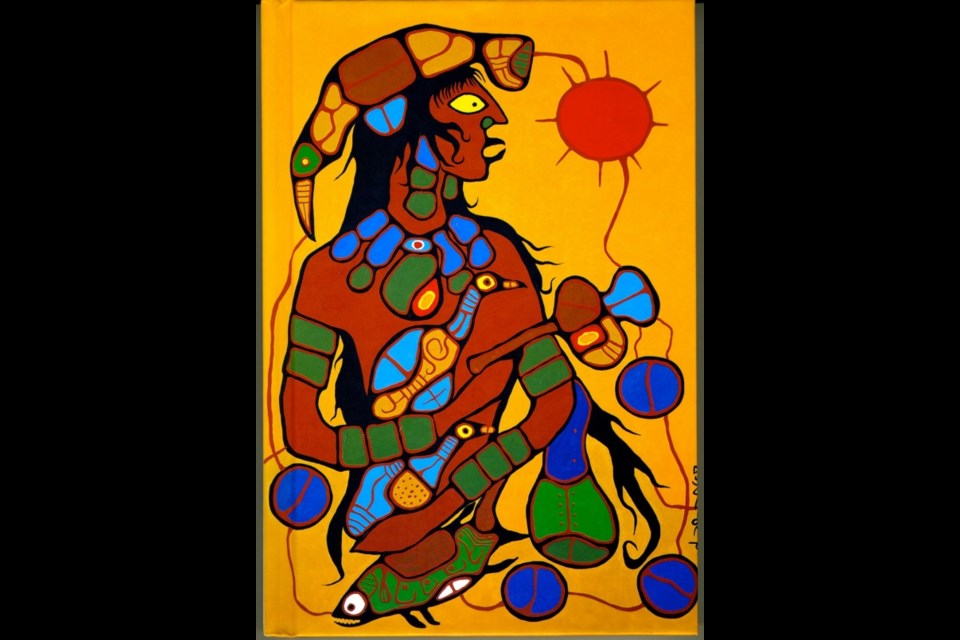The galleries I visit divide into two camps. Some are stores, full of things made for sale. Others are intellectual gymnasiums, where ideas are taken out to play.
Here on the West Coast — more than in other places — many pursue their art practice as a way to connect with what might be called a Higher Power. These dark days of winter are a good time to reflect on those who work toward transcendence.
At the moment, I am inspired by an excellent new book, Norval Morrisseau: Man Changing Into Thunderbird by Armand Garnet Ruffo. Morrisseau was a shaman, bringing the ancient glory of his Ojibway people to the modern world. He lived in Victoria for about eight months in 1982-83, when he met some artists in Fan Tan Alley — Luis Ituarte, Luis Merino, Casey Tebbutt — and made some experimental linoleum-cut prints. Michael Williams bought his paintings for Swan’s Hotel.
Morrisseau painted the stories of his people with simple colours, laid down just as they came from the tube. But in an extraordinary way — more than Inuit or West Coast native prints — his images radiate energy. Victoria’s own Mary Kerr designed a stage show (musical? drama? multimedia?) about his life for the National Arts Centre in Ottawa, and the National Gallery there put on the huge retrospective for Morrisseau while he was still alive.
Being with Morrisseau even for a moment, you knew that you were in the presence of an unusually focused and intensely connected human being. He was an artist with a mission, directed by a force beyond the stars. Later in his life, he settled on this coast, spending his last years in Nanaimo, and passed on in 2007. Meeting him gave proof that there is more to life than this world.
Another painter with the cosmic connection was Allan Edwards, a boy from Vancouver Island who went on to design hotels for the Hilton chain all over the globe. He revitalized the Federation of Canadian Artists, did the first conceptual renderings of the University of Victoria campus and initiated the restoration of Bastion Square. The Art Gallery of Greater Victoria was enriched by dozens of gifts from him.
I met Edwards in his later years on Saltspring Island, where he sparked the building of that community’s art centre. He presented me with a book he wrote about his experiences, not as an artist but as a UFO contactee. I can’t help but think that his extraordinary talent was somehow provided to him by the men from the Pleiades. He titled his book Another Voice in the Wilderness.
Jack Wise was my teacher at the Victoria College of Art in 1978 and the time spent with him taught me that transcendence was the proper goal of the creative discipline. A boy from Iowa, in adult life Wise merged his experience in northern India with the Tibetan refugees and the excesses of West Coast hippie 1960s psychedelia. His personal mandalas were influenced by the “white writing” of Mark Tobey of Seattle, who had brought home the calligraphic touch from the Zen priests in Japan. That is the same Tobey who was brought to Victoria first by Emily Carr in 1924 to teach in her “House of All Sorts.”
In fact, Carr was the greatest transcendentalist of us all. She was inspired by the poems of Walt Whitman and the personal encouragement of Lawren Harris, who moved to Vancouver in 1940 and painted transcendent abstracts until his death in 1970. Harris, beyond being the founder of the Group of Seven, was a lifelong Theosophist. Carr eventually went her own way, and her late paintings are not about trees but about an inherent rhythm in the “light swooping through,” a primal energy of the natural world that is almost animist.
I'll never forget the visits by Tibetan monks who created sand mandalas in the Art Gallery of Greater Victoria. What an honour to be there when these monks filed in at 9 a.m. and, with preparatory chanting, concentrated their energies to make extraordinary geometric mind maps, one grain of coloured sand at a time. Om mani padme hum.
The flowering of native culture is going on all around us, growing from the ancient root stock. To visit the Songhees Nation’s Wellness Centre (just off Admiral’s Road) is by turns breathtaking and humbling. Here, storytellers are carving the legends of their people who have been fishing these waters for millennia. Their masks and dances give evidence that transcendence continues to be possible.
Among the artists I have met a few seem beatific. The late Rachel Berman's physical problems made her life a cruel penance, yet she lived with surpassing joy. Her paintings see into the deepest realms of human experience and bring back a sweet acceptance of life. She was frail and yet created endlessly, giving more than she sold as creativity poured forth from her charming, contorted and poetic soul. Rachel was touched by an angel.
E. J. Hughes of Shawnigan Lake and Duncan painted the south Island. Hughes was a simple soul, who did not strive to transcend but gave his entire attention to the appearance of things. He worked very hard. A widower with no children, he stayed home and followed a routine. He had no hobbies; all was in service to his paintings, mostly of the waterfront around Duncan. He depicted the waters and wooded shoreline, every log on the beach, with a loving devotion. And the results of his devotion are, somehow, transcendent.
Art can take us higher.
Norval Morrisseau: Man Changing Into Thunderbird by Armand Garnet Ruffo, Douglas and McIntyre, Vancouver, 312 pages, 2014, $32.95.
